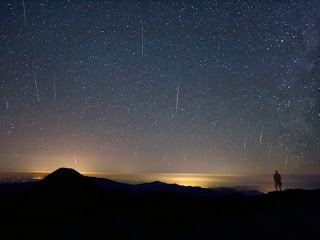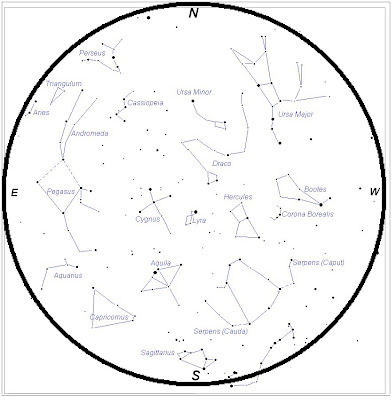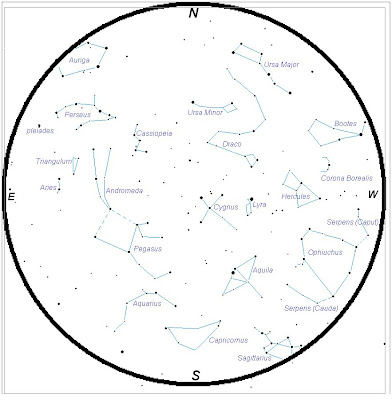 (please click on the image to go to the source for the above photo)
(please click on the image to go to the source for the above photo)
..........Allow me to now take a step backwards. One of the romantic draws of the night sky is the unchanging nature of the sky. If you could step into a time machine and step out on the same night of the year during the time of the first dynasty in Egypt, the sky would appear the same as it does tonight. (Well, someone who has observed for years might -- and I emphasize the "might" -- notice a slight difference in the position of a handful of stars, and the sky would be darker because there would be no city lights, near or far, vomiting out photons to make sure we don't miss a Burger King or a Wal-Mart, and the sky would be turning about a noticeably different point ... but I digress, and that belongs to my discussion of the Little Dipper.) As far as the stars are concerned, the sky would be the same. Certainly, if you have done something outside with your parents the sky will be the same when you do it with your children. Even with this, the most notable occurrences are those times that act against a temporary screen against the "permanence" of the unchanging heavens. Comets, shooting stars, and the predictable motions of the planets tend to draw our eyes first, something that defines the now against a backdrop with an unchanging, uncaring nature. These things are personal, even friendly.
..........Meteor showers are also excellent opportunities to get more into astronomy, or intrduce more people to astronomy. My parents were very supportive of my astronomy, but it can be hard to pull someone out into the cold night to look at a fuzzy bit in a telescope -- after I had been able to find it. The Perseids, especially, were times that other family members came out. I have a lot of memories of going outside as a group to watch the Perseids, even one time going to a state park in Alabama to watch the display.
.........The planets move according to a predictable pattern, bright comets come and go usually as they are discovered; most bright comets are -- individually -- a once in a lifetime object, at best. Meteors (shooting stars), however, come by at about a half-dozen or so a night. Even in suburbia, a patient observer in a lawn chair can expect to see a few each week.
..........Meteors, as a whole, can be divided into three parts. Some fraction of meteors are bits and pieces of rock that never got swept up by a planet, little bits of flotsam and jetsam that have been floating around for a few billion years since the beginning of the solar system. Some are pieces from our spacecraft. NASA traces the motions of thousands of objects that could represent a threat to spacecraft, and when your speed is measured in miles per second, a small nut, bolt, heat shield, etc., can be pretty scary. I lived in central Florida for four years, thirty minutes south of the Kennedy Space Center, and it took a good bit of the romance away from meteor watching realizing that a lot of the meteors I was seeing weren't primordial gypsies, but bits and pieces of junk, haunting the orbits where they had originally been sent. (Without specifically applied energy, a satellite will continue to pass over its launch point.)
..........The third class of meteor originates in comets. When people think of a comet, the bright fuzzy head and long tail are not constant parts of the comet, but creations of the Sun as the comet comes too close. The Sun's energy causes ice, the primary constituent of a comet, to burst from the surface. The bright appearance that people think of when you think "comet" is due to the cloud of reflective ice the Sun forces off of the surface. The tail is ice and gas raised from the comet trailing behind the nucleus. After the comet has begun retreating out to the farther reaches of the solar system, that stuff doesn't disappear, but stays in the same basic orbit. The first few times that the comet passes by the Sun, the ejected dust, dirt, and associated grit stays in the same basic place in the orbit; some meteor showers, like the Leonids in November (more about that then) have big peaks aligned with the period of the comet (in the case of the Leonids, this is every 33 years). The Perseid meteor shower is the result of the Comet Swift-Tuttle, and this is old enough to get a good shower every year. The shower is also young enough to get a good shower every year -- the comet hasn't already seen all its component bits and pieces burn up in our atmosphere.
..........According to most sources the Perseids produce about sixty meteors per hour, but this (like much else) presupposed that you are observing this shower from dark site out in the country. If you are, great! If you aren't, you will see less, but any sort of sky should give you at least twenty meteors an hour on the night of its peak. (There will be meteors for several nights before the peak from this shower, but the meteors will fall off strongly after the peak on the morning of August 12th.) These meteors are called Perseids because they appear to come from a point located in the constellation Perseus (reasonable enough). The reason why is that the stream of particles crosses the Earth's orbit in such a way, and at such an angle as to seem to come from a small area on the globe of the sky.
..........Below is a map of the sky as it appears soon after dark for the first part of August (for those in the latitudes of the upper United States; if you are observing from someplace like northern Europe or Florida, there will be a minor change of perspective, some constellations will be higher or lower to the north/south, but it will be eminently usable). This is an attempt to take the inverted bowl of the sky and squash it down into something that comes more easily out of the printer. To use it, turn the sheet (presumably printing it out first) until the point on the compass at the bottom of the sheet matches the direction in which you are facing. The stars just above the horizon will be the stars at the bottom of the sheet. The constellation of Perseus is just rising in the northeast.
 ..........Here is the night sky a little after midnight, in early August. At this time, the number of meteors should pick up a bit, and they will tend to be brighter than before, because the Earth's atmosphere will be hitting the meteors head-on.
..........Here is the night sky a little after midnight, in early August. At this time, the number of meteors should pick up a bit, and they will tend to be brighter than before, because the Earth's atmosphere will be hitting the meteors head-on. ......... Something that I have none done successfully (so far) is to keep a diary, so to speak, of the Perseids. Using a red flashlight (to avoid ruining your ability to see at night), take a print-out of the sky and sketch the paths of meteors after you see them. If you hope to be out for some time, take several: use one for 10 PM to 10:30, one for 10:30 PM to 11, and so on. One sheet for an extended period of time for the Perseids might look like the one below. This also illustrates why they are named the "Perseids"; if you keep track of the meteors that you see on the night of the eleventh, most of them should appear to radiate out from a point in the constellation Perseus (the "radiant" of the meteor shower, naturally enough).
......... Something that I have none done successfully (so far) is to keep a diary, so to speak, of the Perseids. Using a red flashlight (to avoid ruining your ability to see at night), take a print-out of the sky and sketch the paths of meteors after you see them. If you hope to be out for some time, take several: use one for 10 PM to 10:30, one for 10:30 PM to 11, and so on. One sheet for an extended period of time for the Perseids might look like the one below. This also illustrates why they are named the "Perseids"; if you keep track of the meteors that you see on the night of the eleventh, most of them should appear to radiate out from a point in the constellation Perseus (the "radiant" of the meteor shower, naturally enough).

No comments:
Post a Comment